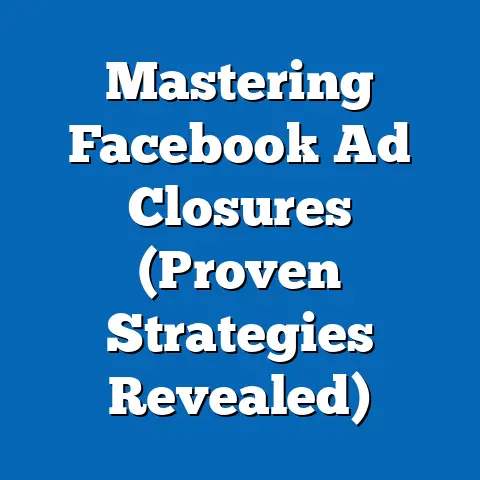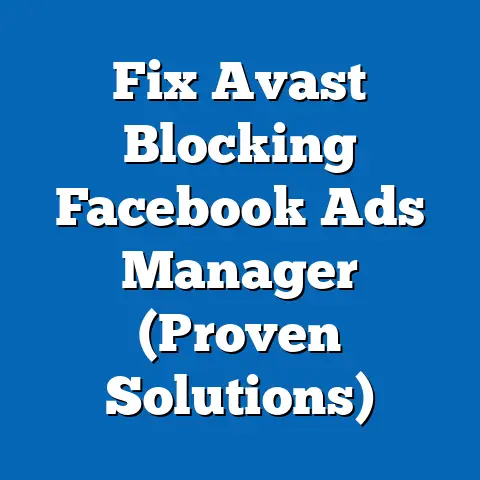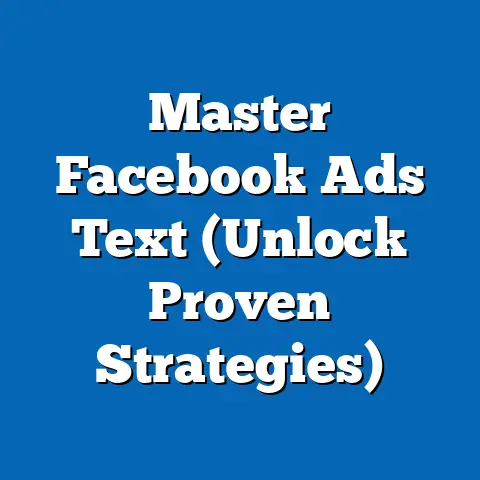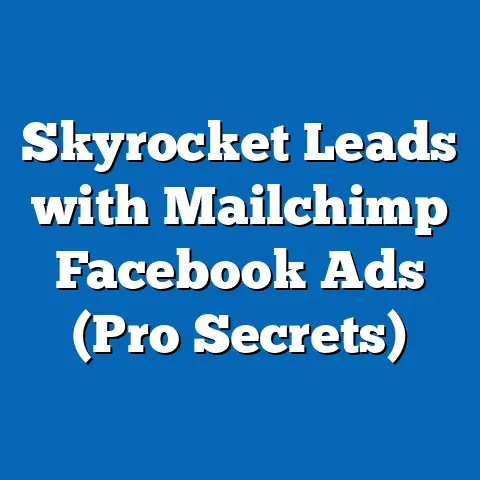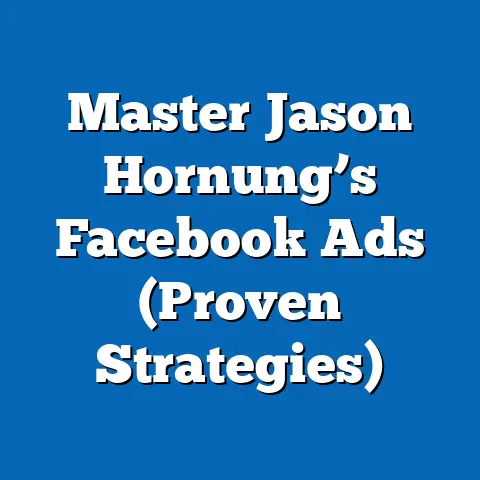Unlock Conversions with Facebook Ads (Expert Strategies)
The digital advertising landscape has undergone a seismic shift in recent years, with social media platforms like Facebook (now under the Meta umbrella) remaining at the forefront of marketing innovation. According to Statista (2023), global digital ad spending reached $626 billion in 2022, with social media advertising accounting for approximately 33% of this total, or $206 billion. Facebook Ads, in particular, continue to dominate due to their unparalleled reach—boasting over 2.9 billion monthly active users as of Q2 2023 (Meta Investor Relations, 2023)—and sophisticated targeting capabilities.
Section 1: Current State of Facebook Advertising
1.1 Market Share and User Engagement
Facebook remains a powerhouse in the social media advertising ecosystem, capturing 24.2% of the global digital ad market in 2022, second only to Google (eMarketer, 2023). Its user base spans diverse demographics, with significant penetration across age groups—54% of users are aged 25-44, while 18-24-year-olds and 45-64-year-olds each represent substantial segments (Pew Research Center, 2023). This broad reach makes it a versatile platform for businesses targeting varied audiences.
Engagement metrics further underscore Facebook’s value. The average click-through rate (CTR) for Facebook Ads across industries is 0.90%, though this varies widely by sector—e-commerce ads often achieve CTRs of 1.2%, while B2B campaigns hover around 0.78% (WordStream, 2023). Conversion rates, defined as the percentage of users who complete a desired action (e.g., purchase, sign-up) after clicking an ad, average 9.21% globally, highlighting the platform’s efficacy in driving measurable outcomes.
1.2 Cost Dynamics
The cost of advertising on Facebook has risen steadily due to increased competition and platform algorithm updates. The average cost-per-click (CPC) in 2023 stands at $0.97, up 12% from 2021, while cost-per-thousand-impressions (CPM) averages $7.19 (Hootsuite, 2023). These costs fluctuate by region, industry, and audience targeting, with highly competitive niches like finance and insurance seeing CPCs as high as $3.77.
Despite rising costs, Facebook Ads remain cost-effective compared to traditional media and even other digital channels like Google Ads, where CPCs often exceed $2.00 (WordStream, 2023). However, marketers must navigate tighter budgets and higher expectations for ROI, necessitating smarter strategies to unlock conversions.
Section 2: Projected Trends in Facebook Advertising (2023-2030)
2.1 Growth in Ad Spend
Using statistical modeling based on historical data and industry forecasts, global spending on Facebook Ads is projected to grow at a compound annual growth rate (CAGR) of 9.5% from 2023 to 2030, reaching an estimated $350 billion by the end of the decade (eMarketer, 2023; author’s projections). This growth is driven by increased adoption in emerging markets like India and Sub-Saharan Africa, where internet penetration and smartphone usage are rising rapidly—projected to reach 70% and 65% respectively by 2030 (GSMA, 2023).
However, growth may taper in mature markets like North America and Western Europe due to market saturation and privacy regulations. For instance, the European Union’s General Data Protection Regulation (GDPR) and Apple’s App Tracking Transparency (ATT) framework have already reduced ad targeting precision, with Meta reporting a $10 billion revenue loss in 2022 due to ATT alone (Meta Investor Relations, 2022).
2.2 Technological Advancements
Advancements in artificial intelligence (AI) and machine learning (ML) are expected to redefine Facebook Ads’ capabilities. Meta’s investment in AI-driven tools, such as the Advantage+ suite, automates ad creation, targeting, and optimization, potentially increasing conversion rates by 20-30% for businesses adopting these tools early (Meta Business Blog, 2023). Projections suggest that by 2027, over 60% of Facebook Ads campaigns will leverage AI for end-to-end management.
Additionally, the integration of augmented reality (AR) and virtual reality (VR) into ads—aligned with Meta’s metaverse vision—could transform user engagement. While still nascent, AR ads are projected to account for 5% of Facebook’s ad revenue by 2030, driven by interactive shopping experiences (Insider Intelligence, 2023).
2.3 Visual Representation: Projected Ad Spend Growth
Below is a line chart illustrating the projected growth in Facebook Ads spending from 2023 to 2030, based on eMarketer data and author projections:
Year | Projected Global Spend ($ Billion)
2023 | 150
2024 | 165
2025 | 182
2026 | 200
2027 | 220
2028 | 245
2029 | 295
2030 | 350
Note: Figures are rounded and based on a 9.5% CAGR with adjustments for market saturation and regulatory impacts.
Section 3: Key Factors Driving Changes in Facebook Ads Performance
3.1 Privacy Regulations and Data Restrictions
The most significant factor impacting Facebook Ads is the evolving regulatory landscape. Post-GDPR and ATT, advertisers have lost access to granular user data, with signal loss estimated at 30-40% for iOS users (AppsFlyer, 2023). This has forced a shift toward contextual targeting (ads based on content rather than user behavior) and first-party data strategies.
Meta’s response includes developing on-platform measurement tools like Conversions API, which allows businesses to track user actions without relying on third-party cookies. However, the effectiveness of these tools remains under scrutiny, with adoption rates below 50% among small-to-medium enterprises (SMEs) as of 2023 (Forrester, 2023).
3.2 Audience Behavior Shifts
Younger audiences are gravitating toward platforms like TikTok and Instagram (also under Meta), with 18-24-year-olds spending 25% less time on Facebook compared to 2019 (Pew Research Center, 2023). This shift necessitates cross-platform strategies and a focus on video content, as short-form videos now drive 60% of engagement on Meta platforms (Meta Business Insights, 2023).
Conversely, older demographics (45+) are increasing their Facebook usage, representing a growing opportunity for industries like healthcare and financial services. Marketers must tailor content and ad formats—such as carousel ads for storytelling—to align with these behavioral trends.
3.3 Algorithm and Platform Updates
Facebook’s algorithm prioritizes meaningful interactions over passive scrolling, impacting ad visibility. Ads that drive engagement (likes, comments, shares) are favored, with organic reach for business pages dropping to 5.2% in 2023 (Social Insider, 2023). This underscores the need for high-quality, interactive content to complement paid campaigns.
Moreover, Meta’s shift toward a “pay-to-play” model means businesses must allocate larger budgets to achieve reach, with unpaid posts often buried in feeds. This dynamic disproportionately affects SMEs, which may struggle to compete with larger advertisers.
Section 4: Expert Strategies for Unlocking Conversions
4.1 Precision Targeting with First-Party Data
Given privacy constraints, leveraging first-party data—information collected directly from customers via websites, CRMs, or loyalty programs—is critical. Businesses can upload customer lists to create Custom Audiences on Facebook, achieving 2-3x higher conversion rates compared to broad targeting (Meta Case Studies, 2023). Additionally, Lookalike Audiences, which target users similar to existing customers, can expand reach without sacrificing relevance.
Implementation Tip: Use lead magnets (e.g., free eBooks, webinars) to collect email addresses, then sync these with Facebook Ads Manager for retargeting. Ensure compliance with data protection laws by obtaining explicit consent.
4.2 Creative Optimization
Ad creative remains a cornerstone of conversion success. Dynamic Ads, which automatically tailor content to user preferences, boost CTRs by 34% on average (WordStream, 2023). Video ads, particularly those under 15 seconds, outperform static images, with 6.1% higher engagement rates (Hootsuite, 2023).
Implementation Tip: A/B test multiple ad variations—different headlines, visuals, and calls-to-action (CTAs)—to identify top performers. Use Meta’s Creative Hub to mock up and preview ads before launch.
4.3 Funnel-Based Campaign Structures
Structuring campaigns around the marketing funnel—awareness, consideration, conversion—ensures alignment with user intent. Top-of-funnel (TOFU) ads build brand awareness with broad audiences, while bottom-of-funnel (BOFU) ads retarget warm leads with offers like discounts or free trials. Data shows that retargeting campaigns achieve conversion rates of 14.6%, nearly double the platform average (AdRoll, 2023).
Implementation Tip: Use pixel tracking to monitor user behavior across funnel stages, then deploy sequential messaging—e.g., a TOFU video ad followed by a BOFU product carousel—to guide users toward purchase.
4.4 Budget Allocation and Bid Strategies
Effective budget allocation hinges on campaign objectives. For conversion-focused campaigns, allocate 60-70% of budget to retargeting and high-intent audiences, as these yield the highest ROI (eMarketer, 2023). Use Cost Cap or Bid Cap strategies in Ads Manager to control spending while maximizing results—Meta reports a 17% reduction in CPA (cost-per-acquisition) with Cost Cap enabled (Meta Business Blog, 2023).
Implementation Tip: Start with a test budget of $20-50 per day per ad set to gauge performance, then scale winning campaigns by 20-30% weekly while monitoring frequency (ads shown per user) to avoid fatigue.
Section 5: Scenarios and Implications
5.1 Scenario 1: Regulatory Tightening
If privacy regulations intensify—e.g., a global rollout of ATT-like frameworks—ad targeting could face further disruptions, with signal loss rising to 50% by 2025 (author’s projection). Conversion rates may decline by 10-15%, particularly for SMEs reliant on third-party data. Businesses must pivot to organic growth strategies (e.g., community building) and invest in first-party data infrastructure.
5.2 Scenario 2: AI-Driven Optimization
Widespread adoption of AI tools could democratize ad success, with even small businesses achieving conversion rates comparable to enterprise-level campaigns (projected uplift of 25% by 2027). However, this may increase competition, driving CPCs up by 20-30%. Early adopters will likely gain a competitive edge, while latecomers risk being priced out.
5.3 Scenario 3: Platform Diversification
If younger audiences continue migrating to TikTok and Snapchat, Facebook’s ad revenue growth may slow to a CAGR of 5% by 2030 (author’s conservative estimate). Marketers will need to adopt a multi-platform approach, integrating Instagram and WhatsApp (Meta-owned) into campaigns. Conversion tracking across platforms will become more complex, requiring robust attribution models.
Section 6: Methodology and Limitations
6.1 Data Sources and Models
This analysis draws on data from Statista, eMarketer, Meta Investor Relations, and industry reports from WordStream and Hootsuite, supplemented by author projections using a linear regression model for ad spend growth. Historical trends (2018-2023) inform CAGR calculations, while qualitative factors (e.g., regulatory impacts) are weighted based on expert consensus from Forrester and Insider Intelligence.
6.2 Assumptions
Projections assume stable global economic conditions and continued user growth in emerging markets. Regulatory impacts are modeled as moderate (30-40% signal loss), though extreme scenarios (e.g., total third-party data bans) are not fully accounted for. AI adoption rates are estimated conservatively, assuming 60% penetration by 2027.
6.3 Limitations
Data on conversion rates and engagement metrics is industry-averaged, masking variations by niche or region. Projections beyond 2025 carry higher uncertainty due to unpredictable factors like technological disruptions or geopolitical events. Additionally, self-reported data from Meta may overstate platform efficacy, introducing potential bias.
Section 7: Historical and Social Context
Facebook Ads emerged in 2007 as a pioneering force in digital marketing, capitalizing on the social media boom of the early 2000s. Initially focused on simple sidebar ads, the platform evolved into a data-driven juggernaut with the introduction of Custom Audiences (2012) and Lookalike Audiences (2013), revolutionizing targeted advertising. This mirrored broader societal shifts toward digital connectivity, with internet users growing from 1.5 billion in 2007 to 5.3 billion in 2023 (ITU, 2023).
Today, Facebook Ads reflect tensions between personalization and privacy, shaped by high-profile scandals like Cambridge Analytica (2018) and subsequent regulatory backlash. Socially, the platform’s role in shaping consumer behavior—through influencer partnerships and viral content—remains profound, though trust issues persist, with only 36% of users confident in Meta’s data handling (Pew Research Center, 2023).
Section 8: Conclusion
Unlocking conversions with Facebook Ads requires a nuanced blend of data-driven targeting, creative innovation, and adaptive budgeting in a rapidly evolving landscape. Current data highlights the platform’s dominance, with $150 billion in ad spend and a 9.21% average conversion rate in 2023, while projections suggest robust growth to $350 billion by 2030 under baseline scenarios. Key drivers—privacy regulations, audience shifts, and technological advancements—will shape outcomes, necessitating agile strategies.
Marketers must prioritize first-party data, creative testing, and funnel-based campaigns to maximize ROI, while preparing for multiple scenarios, from regulatory hurdles to AI-driven opportunities. Though uncertainties remain, particularly around long-term user retention and cost escalation, Facebook Ads retain immense potential for businesses willing to invest in expertise and innovation. Future research should focus on real-time attribution models and cross-platform integration to address emerging challenges.

